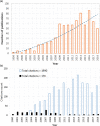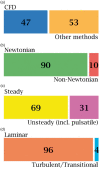What does computational fluid dynamics tell us about intracranial aneurysms? A meta-analysis and critical review
- PMID: 31213162
- PMCID: PMC7181089
- DOI: 10.1177/0271678X19854640
What does computational fluid dynamics tell us about intracranial aneurysms? A meta-analysis and critical review
Abstract
Despite the plethora of published studies on intracranial aneurysms (IAs) hemodynamic using computational fluid dynamics (CFD), limited progress has been made towards understanding the complex physics and biology underlying IA pathophysiology. Guided by 1733 published papers, we review and discuss the contemporary IA hemodynamics paradigm established through two decades of IA CFD simulations. We have traced the historical origins of simplified CFD models which impede the progress of comprehending IA pathology. We also delve into the debate concerning the Newtonian fluid assumption used to represent blood flow computationally. We evidently demonstrate that the Newtonian assumption, used in almost 90% of studies, might be insufficient to describe IA hemodynamics. In addition, some fundamental properties of the Navier-Stokes equation are revisited in supplementary material to highlight some widely spread misconceptions regarding wall shear stress (WSS) and its derivatives. Conclusively, our study draws a roadmap for next-generation IA CFD models to help researchers investigate the pathophysiology of IAs.
Keywords: CFD; Cerebral aneurysm; cerebrovascular blood flow; fluid dynamics; non-Newtonian fluids.
Figures





Similar articles
-
Non-Newtonian Blood Modeling in Intracranial Aneurysm Hemodynamics: Impact on the Wall Shear Stress and Oscillatory Shear Index Metrics for Ruptured and Unruptured Cases.J Biomech Eng. 2021 Jul 1;143(7):071006. doi: 10.1115/1.4050539. J Biomech Eng. 2021. PMID: 33729441
-
Experimental and CFD flow studies in an intracranial aneurysm model with Newtonian and non-Newtonian fluids.Technol Health Care. 2016 May 18;24(3):317-33. doi: 10.3233/THC-161132. Technol Health Care. 2016. PMID: 26835725
-
Evidence for non-Newtonian behavior of intracranial blood flow from Doppler ultrasonography measurements.Med Biol Eng Comput. 2019 May;57(5):1029-1036. doi: 10.1007/s11517-018-1926-9. Epub 2018 Dec 7. Med Biol Eng Comput. 2019. PMID: 30523533
-
Current status of computational fluid dynamics for cerebral aneurysms: the clinician's perspective.J Clin Neurosci. 2011 Oct;18(10):1285-8. doi: 10.1016/j.jocn.2011.02.014. Epub 2011 Jul 26. J Clin Neurosci. 2011. PMID: 21795051 Review.
-
Towards the Clinical utility of CFD for assessment of intracranial aneurysm rupture - a systematic review and novel parameter-ranking tool.J Neurointerv Surg. 2019 Feb;11(2):153-158. doi: 10.1136/neurintsurg-2018-014246. Epub 2018 Oct 19. J Neurointerv Surg. 2019. PMID: 30341160
Cited by
-
On non-Kolmogorov turbulence in blood flow and its possible role in mechanobiological stimulation.Sci Rep. 2022 Aug 1;12(1):13166. doi: 10.1038/s41598-022-16079-5. Sci Rep. 2022. PMID: 35915207 Free PMC article.
-
Investigating the pathophysiology and evolution of internal carotid dissection: a fluid-structure interaction simulation study.Front Neurol. 2024 Sep 30;15:1455989. doi: 10.3389/fneur.2024.1455989. eCollection 2024. Front Neurol. 2024. PMID: 39403267 Free PMC article.
-
The Role of Hemodynamics through the Circle of Willis in the Development of Intracranial Aneurysm: A Systematic Review of Numerical Models.J Pers Med. 2022 Jun 20;12(6):1008. doi: 10.3390/jpm12061008. J Pers Med. 2022. PMID: 35743791 Free PMC article. Review.
-
Analysis of Clinical Effects of Comprehensive Nursing Based on Enhanced Recovery after Surgery in Patients with Embolization for Intracranial Aneurysms.Comput Math Methods Med. 2022 Jul 8;2022:3026680. doi: 10.1155/2022/3026680. eCollection 2022. Comput Math Methods Med. 2022. Retraction in: Comput Math Methods Med. 2023 Dec 6;2023:9832094. doi: 10.1155/2023/9832094. PMID: 35844437 Free PMC article. Retracted.
-
Computational Hemodynamic Modeling of Arterial Aneurysms: A Mini-Review.Front Physiol. 2020 May 12;11:454. doi: 10.3389/fphys.2020.00454. eCollection 2020. Front Physiol. 2020. PMID: 32477163 Free PMC article. Review.
References
-
- Amenta PS, Yadla S, Campbell PG, et al.Analysis of nonmodifiable risk factors for intracranial aneurysm rupture in a large, retrospective cohort. Neurosurgery 2012; 70: 693–699. discussion 699–701. - PubMed
-
- Rashad S, Hassan T, Aziz W, et al.Carotid artery occlusion for the treatment of symptomatic giant carotid aneurysms: a proposal of classification and surgical protocol. Neurosurg Review 2014; 37: 501–511. discussion 511. - PubMed
-
- Brisman JL, Song JK, Newell DW. Cerebral aneurysms. New Engl J Med 2006; 355: 928–939. - PubMed
-
- Wiebers DO, Whisnant JP, Huston J, 3rd, et al.Unruptured intracranial aneurysms: natural history, clinical outcome, and risks of surgical and endovascular treatment. Lancet (London, England) 2003; 362: 103–110. - PubMed
Publication types
MeSH terms
LinkOut - more resources
Full Text Sources
Medical
Research Materials
Miscellaneous

